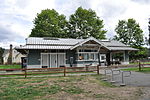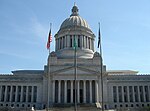Lake Stevens, Washington

Lake Stevens is a city in Snohomish County, Washington, United States, that is named for the lake it surrounds. It is located 6 miles (9.7 km) east of Everett and borders the cities of Marysville to the northwest and Snohomish to the south. The city's population was 28,069 at the 2010 census, but has since grown to an estimated 33,911. The lake was named in 1859 for territorial governor Isaac Stevens and was originally home to the Skykomish in the Pilchuck River basin. The first modern settlement on Lake Stevens was founded at the northeastern corner of the lake in 1889. It was later sold to the Rucker Brothers, who opened a sawmill in 1907 that spurred early growth in the area, but closed in 1925 after the second of two major fires. The Lake Stevens area then became a resort community before developing into a commuter town in the 1960s and 1970s. Lake Stevens was incorporated as a city in 1960, following an exodus of businesses from the downtown area to a new shopping center. The city has since grown through annexations to encompass most of the lake, including the original shopping center, and quadrupled in population from 2000 to 2010. A revitalized downtown area is planned alongside new civic buildings in the 2020s.
Excerpt from the Wikipedia article Lake Stevens, Washington (License: CC BY-SA 3.0, Authors, Images).Lake Stevens, Washington
123rd Avenue Northeast,
Geographical coordinates (GPS) Address Nearby Places Show on map
Geographical coordinates (GPS)
| Latitude | Longitude |
|---|---|
| N 48.019722222222 ° | E -122.06611111111 ° |
Address
123rd Avenue Northeast
98258
Washington, United States
Open on Google Maps




